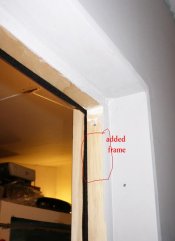esanford
Member
For years I have worked only in medium format and 35mm. I am now taking the plunge into 4X5. I have always been a loyal follower of the late Fred Picker's technique. Therefore, I plan to tray process my sheet film per the Zone VI technique.
I built a very nice darkroom in my home here in North Carolina. However, I've always used a changing bag to load roll film because my DR has light leaks around the door (fortunately, I designed the room to be window-less). I tested to make sure that the light leaks didn't impact paper, and it has not been a problem. Plus, I only used graded papers which is far more ambient light resistant then VC papers. I know it will be an issue for tray developing films in 'total darknes'. Basically, I have just spent my time taking pictures rather then light tightening the room.
So, I would appreciate any help my fellow APUGERs can provide relative to making my door and exhaust vent light tight. Thanks....
Ed Sanford
I built a very nice darkroom in my home here in North Carolina. However, I've always used a changing bag to load roll film because my DR has light leaks around the door (fortunately, I designed the room to be window-less). I tested to make sure that the light leaks didn't impact paper, and it has not been a problem. Plus, I only used graded papers which is far more ambient light resistant then VC papers. I know it will be an issue for tray developing films in 'total darknes'. Basically, I have just spent my time taking pictures rather then light tightening the room.
So, I would appreciate any help my fellow APUGERs can provide relative to making my door and exhaust vent light tight. Thanks....
Ed Sanford
Last edited by a moderator:











 ), and the box is painted flat black, no light makes it's way into the darkroom. Course, since you don't have windows, this isn't an issue for you!
), and the box is painted flat black, no light makes it's way into the darkroom. Course, since you don't have windows, this isn't an issue for you!

